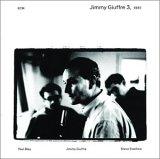Unfairly Overlooked Clarinetist Gets His Due on Double Vinyl
“Jazz” and “clarinet” usually equals Dixieland in the minds of many jazz fans, which may explain, in part, why jazz clarinetist Jimmy Guiffre, a most imaginative, and free-spirited musician failed to achieve the acclaim he deserved-not that there's anything wrong with Dixieland.
This recent double LP reissue by the Jimmy Guiffre 3, combining the two long out of print albums Fusion and Thesis, originally produced by Creed Taylor for Verve back in 1961, and adding some unreleased session material will hopefully alert a new generation of jazz fans (and crusty old ones) to these two ethereal, influential albums.
The trio of Guiffre, Paul Bley on piano and Steve Swallow on bass engaged in a quiet, but powerful musical discussion that emphasized intellect over brute force at a time when loud, brash intense jazz held sway with the musical public-not that there's anything wrong with that either. I don't have to name the names exploding from the firmament of those heady musical times.
These improvisations, sometimes seemingly without form (not to mention tempi or keys), are remarkably inventive and fresh-sounding forty plus years after the fact. It's easy to understand why much of the jazz buying public wasn't buying into this cool, free flowing short-lived ensemble.
Guiffre wrote (or perhaps “conceived” is a better word), all of the material on the two albums, with the exception of two pieces by Carla Bley (Paul's wife at the time, they are now divorced), and one by Gordon Jenkins, his standard “Goodbye.”
The music is contemplative, mysterious, calming, searching, and achingly beautiful. Despite its intellectualism, not a note can be called pretentious, self-conscious, or self-aggrandizing, which is the key to its longevity and continued relevance and freshness.
The grand spaces within the uncluttered music allow the talents of the individual musicians to emerge with great clarity. While there is sometimes dissonance in the music, it never veers off into ugliness or cacophony, nor does it turn saccharine.
The shared search for musical expressiveness within the trio setting keeps the three tethered to the conceptual underpinnings of the compositions and prevents indulgent individual launches. Often you'll hear Guiffre lead with a phrase, which Bley repeats and then embellishes, propelling the trio forward on the wings of Swallow's rhythmic daring.
Fusion, recorded March 3rd, 1961is the more serene of the two sets. Thesis recorded in April, has Guiffre veering off into Coltrane-esque “pillow cases of sound,” with the music taking on a harder, more aggressive, rhythmically charged edge. There's even some humor in “That's True, That's True,” which begins with a quote from Kind of Blue.
Clearly these sessions influenced everyone from Wayne Horvitz to Herbie Mann, whose 1964 collaboration with The Bill Evans Trio (Nirvana, Atlantic 1426) shares a similar cool esthetic, but I could just be talking out of my ass on that one.
Adding to the great pleasures of this double LP set is the superbly natural and transparent recording of the acoustic trio, the gorgeous packaging and photography and the dead silent Pallas pressing, essential to enjoying this quiet, subtle music.
The original recording was remixed in Oslo, June of 1990 by Jan Erik Kongshaug and ECM founder Manfred Eicher, so I can't vouch for this reissue's being “pure analog.” However it was mixed, and from whatever source it was mastered, it is drop dead gorgeous sounding, and very highly recommended.


